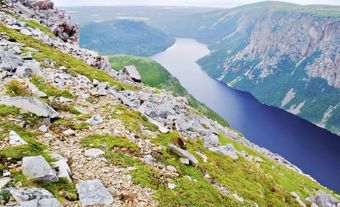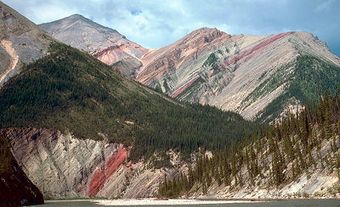Coast Mountains are a continuous mountain chain extending from the Fraser River Lowlands near Vancouver, 1,600 km north into the Yukon. For most of their length they rise abruptly above a coastal strip, facing the Pacific Ocean with rugged slopes and tremendous relief, most extreme where glacial action cuts fjords up to 192 km long (one of only four such occurrences in the world). Some glaciers remain, notably around Mt Waddington, highest point in the chain, and in the Boundary Ranges, north of the Nass River. Most of the Coast Mountains are granitic; ice age volcanic action created the hollow cinder cone of Black Tusk and other features in Garibaldi Provincial Park.
Westerly winds carrying moist air from the ocean drop upward of 430 cm of precipitation a year on the mountains. The exposed slopes are among the rainiest places in North America, nurturing rapid growth of coniferous forests.
Economic Importance
Numerous Northwest Coast Indigenous peoples have long inhabited the coastal edge of the mountains. The first European known to traverse the mountains was Alexander Mackenzie (1793). Roads now cross mountains at eight points, including Hwy 99 between Squamish and Lillooet (mostly following the BC Rail route), Hwy 20 between Anahim Lake and Bella Coola, Hwy 37 between Kitimat and Terrace, Hwy 16 between Prince Rupert and Terrace (also the route of the CN), Hwy 37A between Stewart and Meziaden, Hwy 2 between Skagway and Carcross, Alaska and Hwy 7 from Haines, Alaska up the Chilkoot R.
Great mineral wealth has come from the margins of the mountains. Former sites include the Britannia Beach copper mine near Squamish (museum); gold mines along Bralorne, in the Chilcotin Ranges; the Anyox copper mine and smelter on Observatory Inlet and the Granduc copper mine near Stewart, another in the Taku River area and a granite quarry near Squamish. The aluminum smelter at Kitimat is one of the largest manufacturing plants on the Pacific coast.
Logging is extensive along accessible regions of the coast; logs are boomed or barged great distances to tidewater mills. Pulp mills operate at Port Mellon and formerly at Woodfibre, in Howe Sound. Powell River has a huge pulp and paper complex. On the north coast there are pulp mills at Kitimat and Port Edward. A pulp and paper mill operated for decades at Ocean Falls, on the mid-coast. The east side of the mountains are much drier and more accessible, and truck logging has become extensive in lower-elevation spruce-pine-fir forests.
In the 1990s the British Columbia government created several large protected areas in the mountains, notably Ts'yl-os Prov Pk (233,240 ha) around Chilko Lake, the 317,291 ha Kitlope Valley, south of Kitimat and the 44,902 ha Khutzeymateen Valley near Prince Rupert, Canada's first grizzly bear sanctuary.

 Share on Facebook
Share on Facebook Share on X
Share on X Share by Email
Share by Email Share on Google Classroom
Share on Google Classroom


